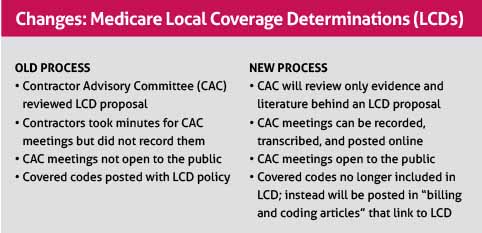
“This isn’t efficacious.” “This has no science behind it. It won’t do anything.” “This is a fraudulent piece of junk.”
These are some things physicians just might say when they’re giving a hard, honest evaluation of a device or a test a vendor is attempting to bring to market in Medicare. Comments like that might have come up in a Contractor Advisory Committee (CAC) meeting, where physicians provide input for Medicare contractors who decide which treatments to cover, known as local coverage determinations (LCDs).
Doctors who shoot straight in those meetings generally don’t have to worry about any repercussions for offering honest expertise. But Garland ophthalmologist John Haley, MD, fears that’s about to change.
Dr. Haley is a member of the CAC for Novitas, the Medicare Administrative Contractor (MAC) with jurisdiction over Texas. Any coverage decision that the federal Centers for Medicare & Medicaid Services (CMS) doesn’t make falls to those local contractors. CACs – which include physician or nonmedical professional representatives for every specialty – meet to review services or items for possible coverage approval. Novitas and other MACs have historically used the CACs’ input to decide whether those treatments, such as a medical device or a test, get covered.
Among other changes in a new CMS directive, the previously closed meetings now will be open to the public, either in-person or via webinar, and can be transcribed and recorded, with the recordings posted online.
Novitas has notified its CAC that it will transcribe and record the meetings going forward, according to information obtained by Texas Medical Association staff.
Dr. Haley worries that vendors, then, can quickly find out which doctors’ comments might have damaged their device’s prospects. That, he says, opens the door for vendors to make trouble.
“They can get that information, and they say, ‘Doctor, you lied. We’re going to sue you.’ That could happen, and that will happen,” he said. “Because that’s the way you suppress the negative views on a lot of these tests that we don’t need.”
TMA is mindful of that concern and has other misgivings about other forthcoming changes to LCDs, in particular the fact that physicians won’t be able to as easily find exactly what’s covered. And Dr. Haley isn’t the only Texas physician serving on the Novitas CAC that foresees problems with the new policies, which Medicare contractors already have begun to implement, CMS says.
Lawsuits and lost influence?
Historically, CACs have met quarterly to review potential new LCDs or discuss changes to existing ones.
Dallas cardiologist Rick Snyder, MD, also a member of the Novitas CAC for Texas, says physicians on the committee previously have commented and taken informal votes on a MAC’s LCD proposal. While the Medicare contractor has always made the final decision, physicians on the CAC offered their input. The committee’s focus, Dr. Snyder says, was almost entirely on the proposal itself. But the changes CMS is requiring will change the CAC’s work considerably.
Under the new federal directive, the committee will review only the evidence and literature that went into developing an LCD proposal, not the proposal itself. In Dr. Snyder’s mind, that’s a dramatic loss of physician influence.
“It makes me feel that they’ve dumbed down the role of the committee to just an evidence evaluation committee, as opposed to an LCD proposal evaluating committee,” he said.
Committee members are open and direct in their evaluations, Dr. Snyder says, and historically none of the discussions were recorded, although sometimes participants would join the meeting by phone or video.
Now that the discussions will be transcribed, recorded, and posted, Dr. Haley believes CAC members are open to getting “hammered by industry.”
That hammer could be a hard one – such as a lawsuit – or a seemingly gentler one – for example, in the form of a device or drug manufacturer’s attempt to influence a CAC member’s decision. The way Dr. Haley puts it: “Then you’ll start getting calls: ‘Why don’t you come on out to dinner with us? Why don’t we take you to the football game?’ All that kind of dirty stuff. It’ll be there. It’ll start.”
Dr. Snyder says that concern is legitimate. “Because you want to be able to be frank. … I do have some industry people who have found out that I’m on the CAC, and they said, ‘Hey we really need help with this device,’ and whatnot,” Dr. Snyder said. “For me personally, I don’t see industry people in my office. I don’t meet with reps, and the only time I have any interaction with them is if they’re leaving drug samples that I can give to my patients who don’t have insurance. … I don’t want to be influenced by industry. And I don’t necessarily want industry calling me and spinning me on the data in terms of my opinions that I’m going to provide [to] the MAC.”

Striving for transparency
Vendors, however, are likely to welcome transparency in how MACs and CACs make coverage decisions on their products.
Matt Bauer is the director of market access for California-based Glaukos Corp., a developer of ophthalmic surgical devices and pharmaceutical therapies for glaucoma. Mr. Bauer told Texas Medicine that Glaukos supports the recording of CAC meetings, including “how they reviewed the evidence and posting comments, certainly. And then also, the CAC has historically been a closed process.
“Historically, we’ve had to determine who the CAC members are in each specialty to really understand some insights. … It should be transparent, and [having] full disclosure to really understand what’s occurring, and why those decisions were made, and what evidence [was] reviewed, I think is certainly important.”
As for concerns about vendors exerting influence on, or retaliating against, physicians as a result, Mr. Bauer believes it would depend on the vendor. He says Glaukos uses randomized clinical trials (RCTs) to get its products to market.
“There may be those vendors that may not have invested fully in RCTs and other data, and they may look at this in terms of some sort of retribution, in terms of lawsuits and things of that nature. … I don’t see Glaukos necessarily suing, litigating a particular CAC member,” he said.
Novitas declined an interview request for this story, referring Texas Medicine to CMS.
A CMS spokesperson responded to written questions from Texas Medicine, saying the agency “has conducted public meetings on coverage topics for over a decade. For example the MEDCAC [Medicare Evidence Development & Coverage Advisory Committee] is comprised of physicians and other health professionals who deliberate in public regarding the strength of evidence for a given topic.” CMS says the Food and Drug Administration holds similar meetings.
“It is common practice for public meetings to be captured for the record,” CMS wrote. “Having a record of a meeting affords those who were unable to attend to still be informed, and therefore allows for greater engagement during public comment. This is in alignment with overall CMS priorities to increase transparency and stakeholder engagement. Multiple stakeholders have requested greater transparency for the local coverage process.”
Code confusion
Another key change – one that raised a red flag for TMA’s Payment Advocacy Department staff – involves the final LCD itself. Previously, MACs posted approved diagnosis and CPT procedure codes on the CMS website as part of the LCD policy. That meant physicians could go online and see exactly what’s covered.
Under CMS’ changes, codes won’t be included in the LCD policies. Instead, the codes will be moved to “billing and coding articles,” educational documents MACs must develop for Medicare’s coverage database. The LCD will contain a link to the billing and coding articles.
“To me it’s a big deal, because if there’s one thing in the Medicare program that’s always been very transparent, it is the LCD policy,” said Genevieve Davis, TMA’s associate vice president of payment advocacy. “And it’s very clear within the LCD policy what needs to be in the medical record; what treatments need to have been tried and failed, if appropriate, for the type of care; and what diagnosis codes are covered in that treatment, and what CPT codes they look at as being applied. That transparency, in some ways, is going away because they’ll now be educational articles.”
CMS, in its responses to Texas Medicine, said the decision to take the codes out of the LCD was made to “promote harmonization” between local and national coverage decisions, which haven’t contained codes since 2006. Moving the codes will allow them to be “efficiently and promptly maintained when coding changes (revisions, retirement, additions) occur … without requiring a reconsideration of the LCD,” CMS said.
The only exception, CMS said, will be durable medical equipment, which will “retain some coding” in the LCD.
Not every physician member of the Novitas CAC is alarmed by the new policies. Houston ophthalmologist David M. Brown, MD, a relative newcomer to the CAC, says the changes are “a step in the right direction for transparency to see how these decisions are made.” Specifically addressing the meetings being open to the public, Dr. Brown said, “Maybe that will make, potentially, people on the CAC more accountable, or who knows? Maybe people will start putting pressure on us about what’s happening.”
However, Dr. Brown does believe the concern about vendors exerting retribution or influence on physicians is a valid one.
“It’s [vendors’] ultimate responsibility to try to convince people and physicians of influence that their technology is worthwhile and helping patients,” he said. “But on the other hand … in theory, the discussion should be evidence-based and literature-based, as opposed to anecdotal. If there’s good, published literature and it’s cost-effective, etc., then I would think the discussion should go that way.”
CMS said in April that MACs were in the process of updating their databases, and the agency expected LCD codes to appear in billing and coding articles by the start of 2020. As of press time, the first Novitas CAC meeting for Texas under the new rules was scheduled for April 25.
Tex Med. 2019;115(6):42-45
June 2019
Texas Medicine Contents Texas Medicine Main Page